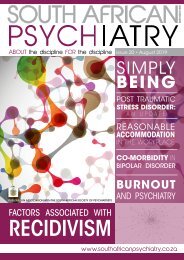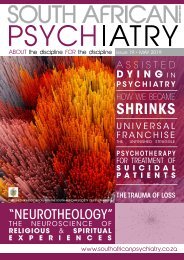South African Psychiatry - February 2019
South African Psychiatry - February 2019
South African Psychiatry - February 2019
You also want an ePaper? Increase the reach of your titles
YUMPU automatically turns print PDFs into web optimized ePapers that Google loves.
CULINARY CORNER<br />
atrium of a large ten storey building where they chose<br />
the floor that they wished to tackle first. Tasks were<br />
graded from easier to more difficult and an attempt<br />
was made for each challenge to be engaging and<br />
entertaining. For example, one of them was: playing<br />
a xylophone near the edge of a floor.<br />
As expected, the researchers found the virtual reality<br />
treatment to be associated with significant changes<br />
in scores on the HIQ (mean change score: -24.5; SD:<br />
13.1) as against the scores of those in the control<br />
group (mean change score: -1.2; SD: 7.3). Treatment<br />
uptake was high and levels of discomfort after a VR<br />
session were very low.<br />
The authors point out that the strength of VR treatment<br />
is that patients are willing to go into situations that<br />
trouble them and to try different ways of responding<br />
because it is a simulation. The learning achieved in<br />
this way has been found to transfer to the real world.<br />
Use of VR can also offer one of the most powerful<br />
aspects of a direct therapeutic intervention - namely<br />
direct coaching in everyday situations that trouble<br />
people.<br />
MAIN MEAL<br />
TREATING PARASITOSIS<br />
The feeling of insects crawling on one’s skin is not in<br />
itself unpleasant. However, it is irritating and most of<br />
us will look quickly to see where the creature is and<br />
swiftly flick or blow it away. How awful it must be if<br />
the cause of the tickling sensation on one’s body<br />
remains hidden - like a ghostly bug. This is a case of<br />
a patient with parasitosis, reported on by Rathi and<br />
Bhatia (2018) in the Indian Journal of <strong>Psychiatry</strong>.<br />
THE INDIVIDUAL CONCERNED WAS A<br />
THIRTY-FOUR-YEAR-OLD HINDU MALE<br />
WHO WORKED IN AN ELECTRONICS<br />
SHOP. HE WAS INITIALLY REFERRED TO A<br />
DERMATOLOGIST ON ACCOUNT OF A<br />
YEAR-LONG HISTORY OF FEELING THAT<br />
AN INSECT WAS CRAWLING OVER HIS<br />
LEGS AT NIGHT. PREOCCUPIED WITH<br />
WORRY REGARDING THIS NOCTURNAL<br />
PEST, HE SUSPECTED THAT HIS BEDDING<br />
MIGHT BE INFESTED, DESPITE HAVING<br />
WASHED IT OUT SEVERAL TIMES.<br />
As might be expected, he was then directed to the<br />
psychiatrists. The authors reported that they started<br />
him on 4mg of blonanserin per day. After two weeks<br />
they increased the dosage to 8mg per day. He was<br />
also given 2mg of lorazepam at night to help him<br />
with sleep (on an SOS basis). There was complete<br />
remission of his symptoms at six weeks and on followup,<br />
at three months, he continued to be well.<br />
MIRROR THERAPY<br />
From ghostly insects to ghostly limbs - it’s bad enough<br />
when the existing parts of a person’s body produce<br />
discomfort and suffering, but how disconcerting to<br />
have one’s amputated body parts evoking pain too.<br />
Phantom limb pain (PLP) happens when there is a<br />
visual-proprioception dissociation in the brain. Mirror<br />
therapy has been used to relieve PLP by resolving<br />
this dissociation. However previous studies into this<br />
treatment modality have been based on small<br />
sample sizes.<br />
Ramadugu et al (2017) carried out a randomized<br />
single crossover study of mirror therapy in the<br />
treatment of PLP in a sample of 64 amputees. The<br />
participants (between the ages of 15 and 75 years)<br />
were randomly distributed into test and control<br />
groups. The test group were made to carry out a<br />
standardized set of exercises for 15 minutes a day in<br />
front of a mirror for 4 weeks. The control group carried<br />
out these tests in front of a covered mirror.<br />
A significant reduction in PLP was revealed in the test<br />
group by means of the visual analog scale and the<br />
short-form Mc Gill Pain Questionnaire (P
















